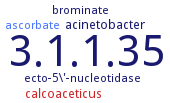3.1.1.35: dihydrocoumarin hydrolase
This is an abbreviated version!
For detailed information about dihydrocoumarin hydrolase, go to the full flat file.

Word Map on EC 3.1.1.35 
-
3.1.1.35
-
calcoaceticus
-
acinetobacter
-
ascorbate
-
brominate
-
ecto-5\'-nucleotidase
- 3.1.1.35
- calcoaceticus
-
acinetobacter
- ascorbate
-
brominate
-
ecto-5\'-nucleotidase
Reaction
Synonyms
3,4-dihydrocoumarin hydrolase, DCH
ECTree
Advanced search results
Substrates Products
Substrates Products on EC 3.1.1.35 - dihydrocoumarin hydrolase
Please wait a moment until all data is loaded. This message will disappear when all data is loaded.
REACTION DIAGRAM
2-chloro-5,5-dimethyl-1,3-cyclohexanedimedon + Br- + acetic acid + H2O2
2-chloro-2-bromo-5,5-dimethyl-1,3-cyclohexanedimedon + acetic acid + H2O
2-chloro-5,5-dimethyl-1,3-cyclohexanedimedon + Br- + peracetic acid
2-chloro-2-bromo-5,5-dimethyl-1,3-cyclohexanedimedon + acetic acid + H2O
3H-benzofuran-2-one + H2O
2-hydroxyphenylacetic acid
-
16% of the activity compared to 7-hydroxydihydrocoumarin
-
-
?
5-hydroxy-3H-benzofuran-2-one + H2O
homogentisic acid
-
82% of the activity compared to 7-hydroxydihydrocoumarin
-
-
?
7,8-dihydroxydihydrocoumarin + H2O
3-(3,4,6-trihydroxyphenyl)propionic acid
-
8% of the activity compared to 7-hydroxydihydrocoumarin
-
-
?
7-hydroxy-6-methoxydihydrocoumarin + H2O
3-(2,3-dihydroxy-3-methoxyphenyl)propionic acid
-
43% of the activity compared to 7-hydroxydihydrocoumarin
-
-
?
delta-D-gluconolactone + H2O
D-gluconate
-
0.8% of the activity compared to 7-hydroxydihydrocoumarin
-
-
?
delta-valerolactone + H2O
5-hydroxypentanoate
-
0.3% of the activity compared to 7-hydroxydihydrocoumarin
-
-
?
methyl-3(4-hydroxyphenyl)-propionate + H2O
3-(4-hydroxyphenyl)-propionate + methanol
-
18.5% of activity with methyl-DL-beta-acetylthioisobutyrate
-
?
peracetic acid
acetic acid + H2O
peracetic acid is likely a natural substrate in vivo, enzyme may play a role in oxidative stress defense system
-
?
additional information
?
-
-
no hydrolysis with gamma-butyrolactone as substrate
-
-
?
2-chloro-2-bromo-5,5-dimethyl-1,3-cyclohexanedimedon + acetic acid + H2O
-
-
-
?
2-chloro-5,5-dimethyl-1,3-cyclohexanedimedon + Br- + acetic acid + H2O2
2-chloro-2-bromo-5,5-dimethyl-1,3-cyclohexanedimedon + acetic acid + H2O
-
-
-
?
2-chloro-2-bromo-5,5-dimethyl-1,3-cyclohexanedimedon + acetic acid + H2O
-
-
-
?
2-chloro-5,5-dimethyl-1,3-cyclohexanedimedon + Br- + peracetic acid
2-chloro-2-bromo-5,5-dimethyl-1,3-cyclohexanedimedon + acetic acid + H2O
-
-
?
2-chloro-5,5-dimethyl-1,3-cyclohexanedimedon + Br- + peracetic acid
2-chloro-2-bromo-5,5-dimethyl-1,3-cyclohexanedimedon + acetic acid + H2O
-
-
-
?
2-chloro-5,5-dimethyl-1,3-cyclohexanedimedon + Br- + peracetic acid
2-chloro-2-bromo-5,5-dimethyl-1,3-cyclohexanedimedon + acetic acid + H2O
-
-
?
3-(2-hydroxyphenyl)propionic acid
-
-
-
?
3,4-dihydrocoumarin + H2O
3-(2-hydroxyphenyl)propionic acid
-
-
-
?
3,4-dihydrocoumarin + H2O
3-(2-hydroxyphenyl)propionic acid
-
-
?
3,4-dihydrocoumarin + H2O
3-(2-hydroxyphenyl)propionic acid
-
-
trivial name melilotate
?
3,4-dihydrocoumarin + H2O
3-(2-hydroxyphenyl)propionic acid
-
-
trivial name melilotate
?
3,4-dihydrocoumarin + H2O
3-(2-hydroxyphenyl)propionic acid
-
-
-
?
3,4-dihydrocoumarin + H2O
3-(2-hydroxyphenyl)propionic acid
-
-
-
?
3,4-dihydrocoumarin + H2O
3-(2-hydroxyphenyl)propionic acid
-
-
?
3,4-dihydrocoumarin + H2O
3-(2-hydroxyphenyl)propionic acid
-
-
-
-
?
3,4-dihydrocoumarin + H2O
3-(2-hydroxyphenyl)propionic acid
-
-
-
-
?
3,4-dihydrocoumarin + H2O
3-(2-hydroxyphenyl)propionic acid
-
60% of the activity compared to 7-hydroxydihydrocoumarin
-
-
?
?
-
key enzyme in the metabolism in the degradation of fluorene. The product could be a substrate for a beta oxidation cycle, to give salicylate
-
-
?
3,4-dihydrocoumarin + H2O
?
-
key enzyme in the metabolism in the degradation of fluorene. The product could be a substrate for a beta oxidation cycle, to give salicylate
-
-
?
3,4-dihydrocoumarin + H2O
?
-
coumarin is converted to dihydrocoumarin by hydrogenation
-
-
?
melilotate
-
the enzyme is specific for 3,4-dihydrocoumarin
-
-
?
3,4-dihydrocoumarin + H2O
melilotate
-
the enzyme is specific for 3,4-dihydrocoumarin
-
-
?
3-(2,3,6-trihydroxyphenyl)propionic acid
-
6% of the activity compared to 7-hydroxydihydrocoumarin
-
-
?
6,7-dihydroxydihydrocoumarin + H2O
3-(2,3,6-trihydroxyphenyl)propionic acid
-
i.e. escelutin
-
-
?
3-(2-hydroxyphenyl)propionic acid
-
-
trivial name melilotate
?
dihydrocoumarin + H2O
3-(2-hydroxyphenyl)propionic acid
-
-
trivial name melilotate
?
dihydrocoumarin + H2O
3-(2-hydroxyphenyl)propionic acid
-
-
trivial name melilotate
?
dihydrocoumarin + H2O
3-(2-hydroxyphenyl)propionic acid
-
-
trivial name melilotate
?
(R)-methylsuccinate + methanol
-
20.7% of activity with methyl-DL-beta-acetylthioisobutyrate
-
?
dimethyl-(R)-methylsuccinate + H2O
(R)-methylsuccinate + methanol
-
20.7% of activity with methyl-DL-beta-acetylthioisobutyrate
-
?
D-beta-acetylthioisobutyrate + methanol
stereospecific hydrolysis
-
?
DL-beta-acetylthioisobutyrate methyl ester + H2O
D-beta-acetylthioisobutyrate + methanol
-
stereospecific hydrolysis
99% enatiomeric excess
?
DL-beta-acetylthioisobutyrate methyl ester + H2O
D-beta-acetylthioisobutyrate + methanol
-
stereospecific hydrolysis, 3.8% of activity with 3,4-dihydrocoumarin
99% enatiomeric excess
?
DL-beta-acetylthioisobutyrate methyl ester + H2O
D-beta-acetylthioisobutyrate + methanol
-
stereospecific hydrolysis, 3.8% of activity with 3,4-dihydrocoumarin
99% enatiomeric excess
?
DL-beta-acetylthioisobutyrate methyl ester + H2O
D-beta-acetylthioisobutyrate + methanol
-
stereospecific hydrolysis
99% enatiomeric excess
?
DL-beta-acetylthioisobutyrate methyl ester + H2O
D-beta-acetylthioisobutyrate + methanol
stereospecific hydrolysis
-
?
2-chloropropionate + methanol
-
1.6% of activity with methyl-DL-beta-acetylthioisobutyrate
-
?
DL-methyl-2-chloropropionate + H2O
2-chloropropionate + methanol
-
1.6% of activity with methyl-DL-beta-acetylthioisobutyrate
-
?
cetraxate hydrochloride + methanol
-
-
-
?
methyl cetraxate hydrochloride + H2O
cetraxate hydrochloride + methanol
-
-
-
?
methyl cetraxate hydrochloride + H2O
cetraxate hydrochloride + methanol
-
-
-
?
(R)-3-bromomethylpropionate + methanol
-
3.5% of activity with methyl-DL-beta-acetylthioisobutyrate
-
?
methyl-(R)-3-bromo-2-methylpropionate + H2O
(R)-3-bromomethylpropionate + methanol
-
3.5% of activity with methyl-DL-beta-acetylthioisobutyrate
-
?
D-beta-acetylthioisobutyrate + methanol
-
stereospecific hydrolysis
-
?
methyl-DL-beta-acetylthioisobutyrate + H2O
D-beta-acetylthioisobutyrate + methanol
-
stereospecific hydrolysis
-
?


 results (
results ( results (
results ( top
top






